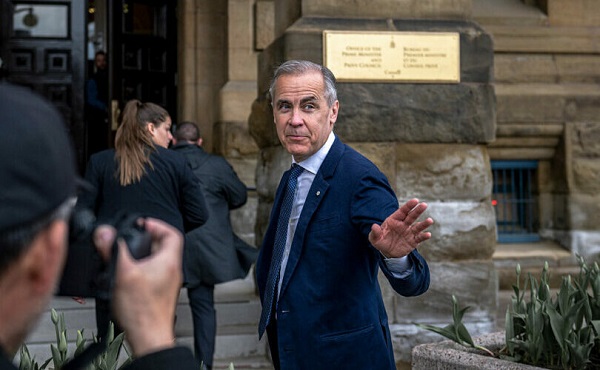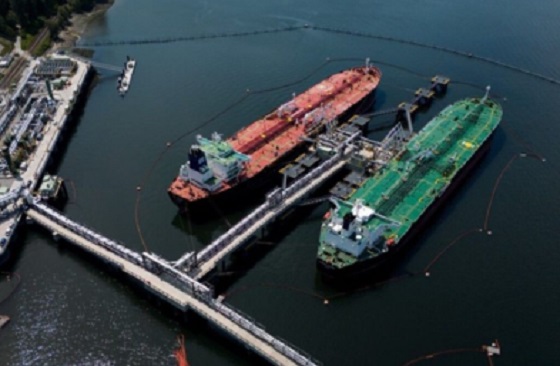Energy
Carney’s energy superpower rhetoric falls flat without policy certainty

This article supplied by Troy Media.
 By Bill Whitelaw
By Bill Whitelaw
Carney’s talk of energy superpower status rings hollow without the policy stability needed to back it up
As Canada continues to slip in global economic rankings, Prime Minister Mark Carney’s ambition to position the country as an “energy superpower” feels increasingly disconnected from reality.
The idea is rooted in recent political rhetoric suggesting that Canada’s energy sector, particularly oil and gas, can drive national prosperity. But
rhetoric alone won’t get us there. Without a clear, workable policy—particularly in how the energy sector is regulated and supported—the path to global energy leadership remains blocked.
Canada has the third-largest proven oil reserves in the world, abundant natural gas and vast renewable resources. Its energy sector supports hundreds of thousands of jobs and contributes significantly to gross domestic product (GDP). Yet despite this foundation, Canada has struggled to translate its natural advantages into sustained global leadership.
The last mandate letter (2021) from former Prime Minister Justin Trudeau to his minister of energy and natural resources focused not on developing Canada’s energy potential, but on dismantling it. The directives prioritized capping oil and gas emissions, eliminating fossil fuel subsidies and accelerating a shift to green alternatives—signalling a clear intention to phase out traditional energy in favour of an ideological climate agenda, rather than supporting Canada’s role as a global energy leader.
Trudeau’s 2021 mandate letter should serve as a cautionary example. These letters, public documents from the prime minister outlining a minister’s responsibilities and policy priorities, must offer more than lofty ideals. If Carney is serious about making Canada an energy superpower, he needs to reflect that ambition in the letter he gives to his minister of energy and natural resources. It should clearly lay out a credible path to unlock energy investment, boost competitiveness and reassert Canada’s global standing.
Canada doesn’t lack ambition. What it lacks is a clear, practical policy framework linking energy—especially oil and gas—to national economic performance. Trudeau’s mandate letter was full of ideals but short on actionable steps. It overlooked the vital role energy plays in growth and prosperity.
Canada’s energy policy landscape is marked by excessive complexity, overlapping regulations and a level of uncertainty that discourages investment. For an industry that operates on long timelines and high capital demands, clarity and certainty are not optional—they are essential.
Without that stability, energy companies can’t plan or invest with confidence. And without robust investment, Canada cannot expect to lead in innovation or longterm economic strength.
The consequences of poor policy are not theoretical. Investment capital has flowed to jurisdictions with clearer rules and faster approvals. Projects that could have created high-paying jobs, increased tax revenues and improved energy security have been delayed or shelved entirely. Canadians are left with higher costs, slower growth and fewer opportunities.
Too often, the connection between energy development and economic strength is treated as secondary when it should be front and centre. This must change. Energy policy should reflect economic realities, not ideological narratives or performative environmentalism.
A better path forward starts with clear priorities grounded in pragmatism. It also demands genuine engagement with industry—not as an afterthought, but from the outset—to ensure policy reflects operational realities on the ground.
This is not a call to surrender oversight to corporate interests. It’s a call to recognize that effective policy requires collaboration with those who drive the economy. A constructive, transparent partnership will better position Canada to meet its environmental goals while advancing energy development.
Reclaiming energy leadership will also require broader alignment across parties, provinces and sectors. Energy policy must outlast political cycles and reflect national interests, not shifting ideological trends. Only then can Canada speak with a credible voice on the world stage.
Clarity and certainty remain the cornerstones of any credible strategy to elevate Canada’s energy leadership. Without them, the superpower narrative is little more than political theatre.
Bill Whitelaw is a director and advisor to many industry boards, including the Canadian Society for Evolving Energy, which he chairs. He speaks and comments frequently on the subjects of social licence, innovation and technology, and energy supply networks.
Troy Media empowers Canadian community news outlets by providing independent, insightful analysis and commentary. Our mission is to support local media in helping Canadians stay informed and engaged by delivering reliable content that strengthens community connections and deepens understanding across the country.
Alberta
Pierre Poilievre – Per Capita, Hardisty, Alberta Is the Most Important Little Town In Canada

From Pierre Poilievre
Energy
If Canada Wants to be the World’s Energy Partner, We Need to Act Like It

Photo by David Bloom / Postmedia file
From Energy Now
By Gary Mar
With the Trans Mountain Expansion online, we have new access to Pacific markets and Asia has responded, with China now a top buyer of Canadian crude.
The world is short on reliable energy and long on instability. Tankers edge through choke points like the Strait of Hormuz. Wars threaten pipelines and power grids. Markets flinch with every headline. As authoritarian regimes rattle sabres and weaponize supply chains, the global appetite for energy from stable, democratic, responsible producers has never been greater.
Canada checks every box: vast reserves, rigorous environmental standards, rule of law and a commitment to Indigenous partnership. We should be leading the race, but instead we’ve effectively tied our own shoelaces together.
In 2024, Canada set new records for oil production and exports. Alberta alone pumped nearly 1.5 billion barrels, a 4.5 per cent increase over 2023. With the Trans Mountain Expansion (TMX) online, we have new access to Pacific markets and Asia has responded, with China now a top buyer of Canadian crude.
The bad news is that we’re limiting where energy can leave the country. Bill C-48, the so-called tanker ban, prohibits tankers carrying over 12,500 tons of crude oil from stopping or unloading crude at ports or marine installations along B.C.’s northern coast. That includes Kitimat and Prince Rupert, two ports with strategic access to Indo-Pacific markets. Yes, we must do all we can to mitigate risks to Canada’s coastlines, but this should be balanced against a need to reduce our reliance on trade with the U.S. and increase our access to global markets.
Add to that the Impact Assessment Act (IAA) which was designed in part to shorten approval times and add certainty about how long the process would take. It has not had that effect and it’s scaring off investment. Business confidence in Canada has dropped to pandemic-era lows, due in part to unpredictable rules.
At a time when Canada is facing a modest recession and needs to attract private capital, we’ve made building trade infrastructure feel like trying to drive a snowplow through molasses.
What’s needed isn’t revolutionary, just practical. A start would be to maximize the amount of crude transported through the Trans Mountain Expansion pipeline, which ran at 77 per cent capacity in 2024. Under-utilization is attributed to a variety of factors, one of which is higher tolls being charged to producers.
Canada also needs to overhaul the IAA and create a review system that’s fast, clear and focused on accountability, not red tape. Investors need to know where the goalposts are. And, while we are making recommendations, strategic ports like Prince Rupert should be able to participate in global energy trade under the same high safety standards used elsewhere in Canada.
Canada needs a national approach to energy exporting. A 10-year projects and partnerships plan would give governments, Indigenous nations and industry a common direction. This could be coupled with the development of a category of “strategic export infrastructure” to prioritize trade-enabling projects and move them through approvals faster.
Of course, none of this can take place without bringing Indigenous partners into the planning process. A dedicated federal mechanism should be put in place to streamline and strengthen Indigenous consultation for major trade infrastructure, ensuring the process is both faster and fairer and that Indigenous equity options are built in from the start.
None of this is about blocking the energy transition. It’s about bridging it. Until we invent, build and scale the clean technologies of tomorrow, responsibly produced oil and gas will remain part of the mix. The only question is who will supply it.
Canada is the most stable of the world’s top oil producers, but we are a puzzle to the rest of the world, which doesn’t understand why we can’t get more of our oil and natural gas to market. In recent years, Norway and the U.S. have increased crude oil production. Notably, the U.S. also increased its natural gas exports through the construction of new LNG export terminals, which have helped supply European allies seeking to reduce their reliance on Russian natural gas.
Canada could be the bridge between demand and security, but if we want to be the world’s go-to energy partner, we need to act like it. That means building faster, regulating smarter and treating trade infrastructure like the strategic asset it is.
The world is watching. The opportunity is now. Let’s not waste it.
Gary Mar is president and CEO of the Canada West Foundation
-

 Business1 day ago
Business1 day agoRFK Jr. says Hep B vaccine is linked to 1,135% higher autism rate
-

 Alberta2 days ago
Alberta2 days agoAlberta Independence Seekers Take First Step: Citizen Initiative Application Approved, Notice of Initiative Petition Issued
-

 Crime2 days ago
Crime2 days agoNational Health Care Fraud Takedown Results in 324 Defendants Charged in Connection with Over $14.6 Billion in Alleged Fraud
-

 Health2 days ago
Health2 days agoRFK Jr. Unloads Disturbing Vaccine Secrets on Tucker—And Surprises Everyone on Trump
-

 Censorship Industrial Complex1 day ago
Censorship Industrial Complex1 day agoGlobal media alliance colluded with foreign nations to crush free speech in America: House report
-

 Bruce Dowbiggin2 days ago
Bruce Dowbiggin2 days agoThe Game That Let Canadians Forgive The Liberals — Again
-

 Alberta16 hours ago
Alberta16 hours agoPierre Poilievre – Per Capita, Hardisty, Alberta Is the Most Important Little Town In Canada
-

 Alberta15 hours ago
Alberta15 hours agoAlberta Provincial Police – New chief of Independent Agency Police Service


